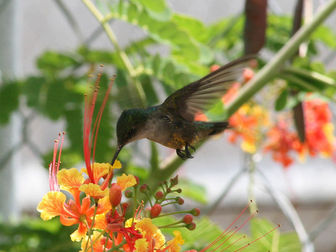Puerto rican emerald
The species displays sexual dimorphism with males and females differing in coloration. The male has iridescent green feathers on its body and a black tail while the female has a white breast and white out tail feathers. They measure 9-10 cm and weigh about 3 grams. The species is found mainly in mountainous regions of Puerto Rico but also occurs along the southwest coast of the main island. Puerto Rican Emeralds are highly territorial, often defending territories with intense aerial pursuits.

Original source: Katka NemčokováPermission(Reusing this file)http://nemcok.sk/copyright.htm
Author: Katka NemčokováPermission(Reusing this file)http://nemcok.sk/copyright.htm
The Puerto rican emerald is classified as Least Concern. Does not qualify for a more at risk category. Widespread and abundant taxa are included in this category.
* Puerto Rican Emerald (Chlorostilbon maugeaus) * Puerto Rican Lizard‑Cuckoo (Coccyzus vieilloti) * Puerto Rican Pewee (Contopus portoricenis) * Adelaide's Warbler (Dendroica adelaidae) * Elfin-woods Warbler (Dendroica angelae) * Puerto Rican Bullfinch (Loxigilla portoricensis) * Puerto Rican Screech Owl (Megascops nudipes) * Puerto Rican Woodpecker (Melanerpes portoricensis) * Puerto Rican Flycatcher (Myiarchus antillarum) More
The Puerto Rican Emerald (Chlorostilbon maugeaus), or Zumbadorcito de Puerto Rico in Spanish, is an endemic hummingbird found only in the archipelago of Puerto Rico. The species displays sexual dimorphism with males and females differing in coloration. The male has iridescent green feathers on its body and a black tail while the female has a white breast and white out tail feathers. They measure 9-10 cm and weigh about 3 grams. More
Puerto Rican Emeralds feed on insects, spiders and nectar. They breed throughout the entire year but breeding is concentrated before the wet season starts from February to May. Eggs are extremely small, measuring 8 by 13 mm. More
Stamps showing Puerto Rican Emerald Chlorostilbon maugaeus Puerto Rican Emerald Chlorostilbon maugaeus Puerto Rican Emerald Chlorostilbon maugaeus Puerto Rican Emerald Chlorostilbon maugaeus Puerto Rican Emerald Chlorostilbon maugaeus Puerto Rican Emerald Chlorostilbon maugaeus Puerto Rican Emerald Chlorostilbon maugaeus Puerto Rican Emerald Chlorostilbon maugaeus 86.049 Puerto Rican Emerald IOC v2.4: 3232 Links will open countrypage in new window - Dominica 28.05. More
Results for: puerto rican emeraldTranslations 1 - 30 of 56 English English Finnish Finnish puerto rican emerald puertoriconsmaragdikolibri, Chlorostilbon maugaeus puerto rican nightjar puertoriconkehrääjä, Caprimulgus noctitherus puerto rican bullfinch puertoriconsirkku, Loxigilla portoricensis puerto rican parrot puertoriconamatsoni, Amazona vittata puerto rican woodpecker puertoricontikka, Melanerpes portoricensis puerto rican screech owl puertoriconpöllönen, Otus nudipes More
puerto rican emerald by so, robyn was walking ahead of me on the path leading towards la mina falls, when she told me to stop. i did what she said, and before i could give it much thought, she asked me if i had my 18-200mm lens on (which i did, and my external flash too). she had me come around the corner very slowly, and when i got there, i saw the tiniest, cutest, little green hummingbird. More
The Puerto Rican Emerald is a tiny, iridescent green hummingbird that measures 3.5 to 4 inches (9 to 10 centimeters.) It can be easily identified by its small size, shiny green body, forked tail and smooth un-crested head. The male is green above and below with a black tail, while the female has a white breast and outer tail feathers tinted with white. A male bird weighs approximately 0.1 ounce (3 grams). More
Puerto Rican Emerald Chlorostilbon maugaeus = Described by: Audebert; Vieillot (1801) Alternate common name(s): Antillean Emerald Old scientific name(s): Reccordia maugaeus Photographs No photographs are available for this species Range West Indies; Restricted range; Puerto Rico. More
Puerto Rican Emerald Hummingbird, Puerto Rican Tody, Puerto Rican Woodpecker, Puerto Rican Flycatcher, Puerto Rican Vireo, Adelaide’s Warbler, Elfin-woods Warbler, Puerto Rican Tanager, Puerto Rican Spindalis, Puerto Rican Bullfinch, Yellow- shouldered Blackbird and two possible endemic species: the Lesser Antillean Pewee and the Greater Antillean Oriole. More
Family : Trochilidae
Genus : Chlorostilbon
Species : maugaeus
Authority : (Audebert & Vieillot, 1801)

